Sinks That Make A Statement
Add Style and Design Plus Functionality
Statement pieces are just that: items in a room that catch our attention and set the stage for the mood you want to set: the “vibe,” if you will.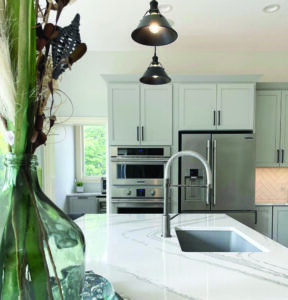
In the past, core bathroom and kitchen appliances were primarily considered functional and often left out when it came to using them to beautify.
Not anymore! On the contrary, sinks are making a splash in the design department.
Often in the center of the room for ease of use and practicality, sinks are the perfect pieces to provide a pop. Their indispensability is undeniable, and now their charm can be as well.
“Statement sinks can be a place the homeowner adds personality and originality to their spaces,” Susan Hirschberg, Architect and Partner of RH Design Build, LLC in Oshkosh, says. “Choose something you love and that will work well for those who will use the space most.”
“Bathrooms are becoming a lot larger,” Scott Ploetz, Store Manager at Gerhard’s Kitchen Bath & Lighting Store in Appleton says. “So a lot of people want to create that space where they can relax and feel like it’s luxury.”
Common Sink Types + Placement
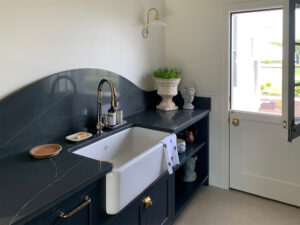 From custom glass and artistic vessel sinks to utilitarian and elegant workstations, the sky’s the limit when it comes to incorporating design and function into your home with sinks.
From custom glass and artistic vessel sinks to utilitarian and elegant workstations, the sky’s the limit when it comes to incorporating design and function into your home with sinks.
The first step to determining which works best for your space and style is knowing your options:
Undermount sinks are the most common style. Their distinctive advantage is that they are mounted under the countertop. This allows counters to be cleaned easily.
Overmount sinks sit on top of the countertop. The rim of the sink provides a nice accent to the stone, and allows the sink to become a more prominent feature of the countertop.
Farmhouse sinks are generally mounted under the countertop. The defining feature is that the front of the sink is exposed. These sinks can provide a rustic feel to your kitchen, but also work remarkably well with modern designs.
Vessel sinks sit on top of the countertop, fully exposed. They are generally used in bathrooms or utility areas. They provide a beautiful decorative accent to your countertop.
Choosing a type of sink largely depends on placement.
“Where is the sink going?” Elisabeth Schaser, owner, founder and principal designer at Front Porch Design Studio in Appleton, asks. “In a kitchen sink, I prefer to select an undermount sink for ease of cleaning.
“In a bathroom sink, one can really have some artistic fun depending on the type of bathroom. If the sink is going in a children’s bathroom, I like to utilize an undermount sink for ease of cleaning. In an owner’s en suite, depending on the desired style and wish of the client, one can go as practical as an undermount to an artistic vessel with flare.
“In a powder room, depending on the desired aesthetic this room can have a sink with a ‘WOW’ factor, such as custom artwork, custom glass, and custom metal finishes and textures.”
“In a kitchen, it depends on if you want the sink as a statement,” Hirschberg adds. “An apron front sink will stand out more so than an undermount sink. An apron front sink can give the kitchen a cottage-like feel or add a splash of color.
“A note on an apron front sinks; depending on the material, it’s possible for marks to show up over time if scratched by belts or buttons.
“A powder room is a great place for a statement sink like a vessel or interesting all stone wall mount sink. In a powder room you can save cost by using a pedestal sink which eliminates a vanity expense but you forgo the storage of a vanity. If a bathroom will see lots of use, undermount sinks will be a good design choice, as they’ll allow for storage and easy cleaning.”
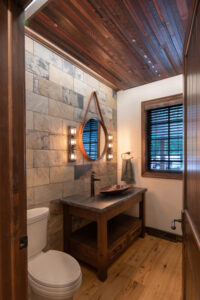
D850
Stainless steel and Composite are the most commonly used materials for kitchen sinks—chosen due to their durability. Composite sinks have the added advantage of coming in many different colors. Both materials are very durable and should last a long time, with proper care and maintenance.
Cast iron sinks, while not as common, are still used in both vanities and kitchens. They are very durable, but also very heavy and require extra work to install.
Porcelain sinks are chosen for more than 90% of the vanity jobs that we install. They come in both overmount and undermount styles. Due to their tendency to break or chip upon heavy impact, they are not advised for kitchen sinks, but they are a perfect choice for vanities.
Copper and glass sinks are more common in vanities. They often come in vessel style sinks that add an elegant feel to bathroom projects.
Natural stone sinks, made from materials such as granite, marble, onyx or travertine, are a far less common choice for most homeowners. They look amazing, but are expensive and durability can be an issue.
“One thing to note with kitchen sinks is the variety of accessories that each particular sink company offers: from cutting boards that slide from side to side, helping with food prep to drying racks placed over the top portion of the sink assisting in dishware cleaning,” Schaser explains. “A hot tip: when purchasing a new kitchen sink, look for a sink that offers a fitted rack for the bottom of the sink. This will help alleviate scratches to the bottom of the sink, thus prolonging the life of the sink.”
Trending Design and Technology Elements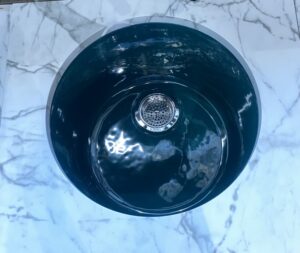
Like in everything it seems, past trends are having a resurgence when it comes to sink design in 2024 and beyond.
“French Gold is big,” Ploetz says. “But it is softer and more modern looking than the trendy gold in the ‘80s.”
“I’m seeing and enjoying utilizing vintage profile sinks that give a nod to past eras,” Schaser says. “A trend in 2024 are sinks in different metal finishes. However, be mindful of where this type of sink will be utilized as depending on the metal it can easily scratch.
“A type of kitchen sink I enjoy specifically is a composite sink. This new type of technology in a kitchen sink delivers a solid product that can withstand wear and tear, scratches and stains from everyday use, thus maintaining its ‘new’ look. These sinks also offer a variety of basin and bowl sizing to one’s preference along with dividers placed where the client feels it is best for personal use. The sink divider can be full height or 1/2 height offering ease for cleaning larger items.”
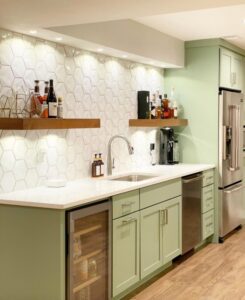 “Kitchen-wise, the type of sink that is growing in popularity is the workstation sink,” Ploetz adds. “A lot of times those come with a lot of additional amenities like strainers, cutting boards… they lock right into the sink. You can do everything right at your sink. It could be basic but there are some that come with drying racks, baskets to rinse fruits and vegetables. There are a lot of different functions. They are becoming increasingly popular.”
“Kitchen-wise, the type of sink that is growing in popularity is the workstation sink,” Ploetz adds. “A lot of times those come with a lot of additional amenities like strainers, cutting boards… they lock right into the sink. You can do everything right at your sink. It could be basic but there are some that come with drying racks, baskets to rinse fruits and vegetables. There are a lot of different functions. They are becoming increasingly popular.”
Ploetz says large single bowls are also coming back into frame in kitchens. People are moving away from double bowls. Less people are hand washing dishes, using dishwashers. Single bowls make it easy to wash large items.
‘Smart’ technology is also finding its way to the kitchen and bathroom too.
“From sensors and connectivity tech that tracks water usage, cleanliness, preferred temp and flow settings, and more,” Hirschberg says. “We’re likely to see more technology that aids sustainability and conservation around water usage in the near future.”










Leave a Comment